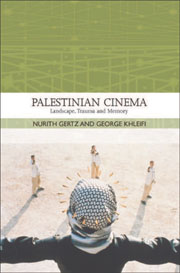Book contents
- Frontmatter
- Contents
- TRADITIONS IN WORLD CINEMA
- Dedication
- Introduction
- 1 A Chronicle of Palestinian Cinema
- 2 From Bleeding Memories to Fertile Memories
- 3 About Place and Time: The Films of Michel Khleifi
- 4 Without Place, Without Time: The Films of Rashid Masharawi
- 5 The House and its Destruction: The Films of Ali Nassar
- 6 A Dead-End: Roadblock Movies
- 7 Between Exile and Homeland: The Films of Elia Suleiman
- Conclusion
- Epilogue
- Bibliography
- Filmography
- Index
Introduction
Published online by Cambridge University Press: 05 August 2013
- Frontmatter
- Contents
- TRADITIONS IN WORLD CINEMA
- Dedication
- Introduction
- 1 A Chronicle of Palestinian Cinema
- 2 From Bleeding Memories to Fertile Memories
- 3 About Place and Time: The Films of Michel Khleifi
- 4 Without Place, Without Time: The Films of Rashid Masharawi
- 5 The House and its Destruction: The Films of Ali Nassar
- 6 A Dead-End: Roadblock Movies
- 7 Between Exile and Homeland: The Films of Elia Suleiman
- Conclusion
- Epilogue
- Bibliography
- Filmography
- Index
Summary
“History has forgotten our people,” writes Yazid Sayigh (1998) about the Palestinians, while Emile Habibi, in his book The Six Day Sextet (1968a), presents the opposite position: “We are the people who have overlooked history.” Today, with the establishment of Palestinian nationality and its historical narrative in writings, art, and literature, both positions seem inaccurate. Yet, the notion that the post-1948 Palestinian historical narrative has thus far not been told in its entirety or, at least, that it has yet to find its full artistic expression, is still prevalent among writers and scholars. According to Anton Shammas, we can certainly find parts of this story in individual literary works such as The Pessoptimist (Habibi, 1974), Arabesque (Shammas, 1986), Returning to Haifa (Kanafani, 2000), and “Why Have You Abandoned the Horse?” What is missing, however, is the overall story: “the experience of being uprooted, the banishment and the crime, the absence” (Khouri, 1998).
Researchers tend to cite various causes that have led to this predicament. Some remark that “chunks of the Palestinian memory have been subjected to colonization by other types of discourse” (Nassar, 2002: 27-8) and have been silenced by the Israeli narrative (Manaa, 1999b; Said, 2000). Consequently, Palestinian history has been told from the viewpoint of the winning side. As Manaa would argue:
The Europeans followed by the Zionists – the powerful and triumphant side in the national conflict over the Holy Land … generally ignored even the mere existence of the indigenous people of the land and their right over the country … The Palestinians have been described as nomads, as peasants, or as miscellaneous groups and sections lacking any national consciousness.
(Manaa, 1999b: 9–10)- Type
- Chapter
- Information
- Palestinian CinemaLandscape, Trauma and Memory, pp. 1 - 10Publisher: Edinburgh University PressPrint publication year: 2008



